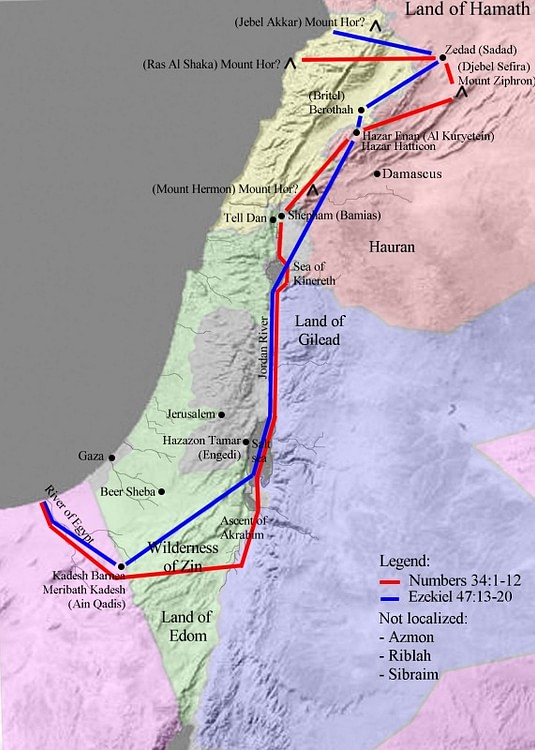LAND of CANAAN

Canaan is an ancient term for a region approximating present-day Israel, the West Bank and the Gaza Strip, plus adjoining coastal lands and parts of Lebanon, Syria, and Jordan.
Canaanites are mentioned extensively in the Bible, as well as in Mesopotamian and Ancient Egyptian texts. According to the Bible, the land of Canaan was the "promised land" which God gave to Abraham and his descendants.
The Canaanites themselves, however, were considered to be the implacable enemies of the Israelites, who practiced a decadent and idolatrous religion. Contemporary archaeologists, however, see much continuity between the Canaanite population and the early Israelites, with whom they shared a common language and customs.
The term "Canaan land" is also used as a metaphor for any land of promise or spiritual state of liberation from oppression. Moses' journey from Egypt to the promised land of Canaan thus symbolizes a people's journey from oppression to freedom, from sin to grace.
Historical overview
Human habitation of the land of Canaan goes far back with both Cro-magnon and Neanderthal skeletons having been unearthed from Paleolithic times. A settled agricultural community was present at Jericho from about 8000 B.C.E. By 3000 B.C.E., settlement in towns and villages was widespread.
The earliest written mention of the area later called Canaan comes in the eighteenth century B.C.E. in Mesopotamian sources. The term Canaan and Canaanite first appear around the fifteenth century B.C.E. in cuneiform, Phoenician, and Egyptian, inscriptions.
Semitic peoples are thought to have appeared in Canaan in the early Bronze Age, prior to 2000 B.C.E. Writing began to appear shortly thereafter. The Semitic people known as the Amorites became the dominant population group during this period, migrating from the northeast. Also entering from the north were the Hurrians (Horites). Egyptians and the Hyksos, (see below) entered the region from the south.
In the Late Bronze age (1550-1200 B.C.E.), Egypt controlled most of Canaan through a system of vassal city-states. Hittite and Apiru (possibly Hebrew) attackers sometimes captured Canaanite towns or harassed them from the countryside. Israelite civilization began to emerge in the historical record in the late thirteenth century B.C.E., with a mention on the Merenptah stele among those nations conquered by the Egyptian monarch.
Historians debate whether Israel's rise represented an invasion, gradual infiltration, a cultural transformation of native Canaanite population, or a combination of the above. With the establishment of the kingdoms of Judah and Israel, the Canaanite, Philistine, and Phoenician peoples co-existed with the Israelites (though not always peacefully), along with other populations such as the Amorites, Edomites, and Moabites to the east and south.
From the tenth through the seventh centuries, these nations were strongly pressured and sometimes conquered by Syrian, Assyrian, Egyptian, and finally Babylonian forces. The latter finally came to a position of complete dominance in the sixth century B.C.E.
Etymology and early references
The Canaanite language refers to a group of closely related Semitic languages. Hebrew was once a southern dialect of the Canaanite language, and Ugaritic, a northern one. Canaanite is the first language to use a Semitic alphabet, from which most other scripts derive.
Historically, one of the first mentions of the area later known as Canaan appears in a document from the eighteenth century B.C.E. found in the ruins of Mari, a former Sumerian outpost in Syria. Apparently, Canaan at this time existed as a distinct political entity (probably a loose confederation of city-states). Soon after this, the great law-giver Hammurabi (1728-1686 B.C.E.), first king of a united Babylonia, extended Babylonian influence over Canaan and Syria.
Tablets found in the Mesopotamian city of Nuzi use the term Kinahnu ("Canaan") as a synonym for red or purple dye, apparently a renowned Canaanite export commodity. The purple cloth of Tyre in Phoenicia was well known far and wide.
The Bible attributes the name to a single person, Canaan, the son of Ham and the grandson of Noah, whose offspring correspond to the names of various ethnic groups in the land of Canaan (Gen. 10).



Post a Comment